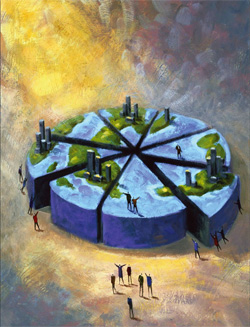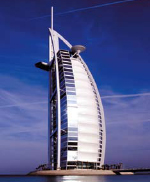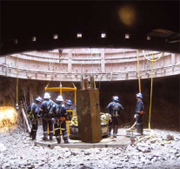|
SEPTEMBER 2008 |
 |
|
 |
| Home | | |
Message from CE | | |
Cover story | | |
Excellence | | |
Major Projects | | |
People | | |
| |
Awards |
| Currently viewing: Cover story / Next: Excellence |
Cover story

With 50% of its business generated in resource and infrastructure-based global markets, Murray & Roberts has become an attractive long-term investment for foreign shareholders seeking exposure to both the global commodity and South African infrastructure booms
South Africa has so much to offer its people and the world, yet allegations of crime and corruption, power shortages and anti-immigrant attacks have taken their toll on the country’s image around the world. This has become increasingly evident at international investor meetings, where shareholder perceptions vary from absolute dismissal to grudging acceptance of the current status. “Only investors in the resources and construction sectors are really happy,” says Murray & Roberts group CE Brian Bruce.
Foreign shareholders are vital to sustaining a strong share price and global stature. “South African investors tend to have a short-term view of the industry, with still-painful memories of the 25-year construction drought, whereas foreign investors take a more strategic view and are inclined to pay a premium for the long-term prospects of the industry,” says Brian.
Murray & Roberts has positioned itself as an attractive global investment: at the moment, about 40% of its business is located outside South Africa, and of the 60% remaining within the country, another 10% (of the total) is fully exposed to the global commodities cycle. The split is therefore 50/50, and the ratio is likely to be maintained over the coming decade, as some of the Group’s uniquely South African capability is poised to grow offshore as well.
“There are essentially two stories to Murray & Roberts: we’re well exposed to the global commodities cycle; but we’re equally exposed to the South African infrastructure cycle. Our organisation is now structured with sufficient flexibility to grow at least as strongly as each of these cycles,” explains Brian.
The offshore business of Murray & Roberts is grouped into three high-growth areas: oil, gas and energy in Southeast Asia and Middle East; mineral resources in North America and Australasia; and commercial fixed investment in Middle East. Much of the Group’s business is therefore driven by resources, whether directly or indirectly, and the need to provide infrastructure.
“Whereas we are currently active in three geographic regions, that could change based on where our expertise and strategy leads us.”
MIDDLE EAST
Free cash flow from record oil prices in recent years underlies the remarkable success story of the Middle East. This free cash flow has been drawn from the rest of the world to fund infrastructure development in countries such as the United Arab Emirates Qatar and Bahrain. Though the oil price is currently falling, Murray & Roberts views this as part of the inevitable price volatility within a range, and not as a structural return to previous levels of a few years ago.
“Our business in the region is growing fast, and over the next few years, the Middle East operation will become the single biggest part of the global Murray & Roberts business.”
“High oil prices are here to stay, though maybe not as high as $150/barrel. The good news is that the wealth generated is being used constructively to build infrastructure for a long-term future. This may be a new concept to the region, but there are many historic precedents for such a strategy.” South Africa did the same in the 50s and 60s on the proceeds of gold revenue, developing an infrastructure that has stood the country in good stead for many years.
“Such fixed investment has a direct multiplier effect on commercial and business opportunities, and Murray & Roberts is positioned in both the infrastructure and high-end commercial space in the Middle East, as a preferred bidder well connected with both government and major industry players,” Brian says.
“Our business in the region is growing fast, and over the next few years, the Middle East operation will become the single biggest part of the global Murray & Roberts business.”
Currently, the Middle East contributes 12,5% of group business, a percentage budgeted to increase to 20% by 2011. There may also be spin-offs for the Group in other regions. The Emirates is investing not just in its own infrastructure, but also in developing economies around the world, and Murray & Roberts is in line to win some of these projects given its preferred relationships in the region.
While the Middle East business is not strictly speaking a commodities or energy-driven one (as are the other two global businesses, as well as much of the South African operation), Brian points out that there is a synergy insofar as it is funded by oil and gas revenue.
LONDON
From a logistics perspective, Murray & Roberts has long maintained a strategy that any geography it operates in must be accessible by an overnight flight. This accommodated locations such as the Middle East, Australia and Europe, but presented a challenge when opportunities arose in Canada, which dovetailed with the Murray & Roberts strategy of focusing on energy and commodities businesses.
When the Group acquired Cementation Canada in 2004, it recognised that an additional, satellite corporate office would be necessary for logistical reasons. Resourcing some of the international businesses might be better achieved from London than South Africa. Consequently, a corporate office was established in London in 2004, enabling South Africa to withdraw from direct management of businesses it could not easily access. This forced the Middle East operation to resource itself independently out of global resources, and offered the Group a global view of the world market.
CANADA
The Canadian operation underscored the fact that the Murray & Roberts strategy was increasingly focusing not so much on geographies as on areas of core expertise. South Africa had pioneered deep-level mining, and it was becoming clear that many mines elsewhere in the world were going underground – especially in Australia and Canada – creating demand for this South African expertise. Murray & Roberts now had operations in both countries, and could easily export this technology to both.
There are a number of similarities between the Australian, Canadian and South African markets: a common language and cultural heritage as part of the Commonwealth, each is at the extremity of a continental mass that dominates its world view (Asia, North America and Africa respectively) and each is rich in resources.
MIDDLE EAST
Murray & Roberts has developed a reputation as a world class contractor in the Middle East with the successful delivery of a number of iconic mega projects in the region. The Group established a presence there in 1995 and placed its signature on the Dubai skyline with the completion of the Burj al Arab in 1999.
Strong oil revenues in the region have fuelled unprecedented levels of growth in fixed capital investment as the countries in the region have invested in the expansion of their domestic economies.
As unabated growth in the development of commercial infrastructure has placed increasing pressure on construction capacity in the region, Murray & Roberts as a bestin- class contractor has been able to secure negotiated partnerships with clients, which has positioned it for major hospitality and airport projects.
In line with the Group’s strategy to pursue major projects in the Middle East, construction activities in the region have recently been dominated by the R10 billion Dubai International Airport Terminal 3 and Concourse 2 contract where Murray & Roberts is leader of a joint venture with local partner Habtoor Engineering and Takenaka of Japan. The joint venture completed Phase 1 of the project successfully in 2007, in spite of accelerated schedule obligations, and the quality of this major international project is likely to attract world-wide recognition when it opens to the public.
 |
| Burj al Arab Hotel, Dubai |
In recent years, Murray & Roberts has successfully delivered a range of other major projects throughout the United Arab Emirates, including the BurJuman mixed-use development in Dubai, the Goldcrest Tower residential development in Jumeirah Lakes, Dubai, and the Durrat Bridges and World Trade Centre in Bahrain. The Al Raha Beach project in Abu Dhabi, which is currently being completed by Murray & Roberts Marine, has facilitated the formation of a new waterfront, with prime development land stretching over more than 14 kilometres of the new coastline.
This year, Murray & Roberts and its partners were awarded the R13 billion Tameer Towers project in Abu Dhabi, the largest project the Group has undertaken in the Middle East. Other projects won during the year include the prestigious R6 billion Trump International Hotel & Tower on the Palm Jumeirah in joint venture with Al Habtoor and the R2,5 billion Sorbonne University in Abu Dhabi.
A strong track record in the construction market has provided a platform for entry into other sectors in the region and Murray & Roberts has experienced rapid growth in the steel and construction services sectors. Murray & Roberts Steel, in partnership with its local partner, the Kanoo Group, is building a new facility which will quadruple the volume of rebar and mesh Murray & Roberts supplies to the local market to almost 300 000 tons per annum, positioning the Group as one of the larger suppliers to the burgeoning Middle East steel market. Johnson Arabia has tracked the growth profile of the region since it was launched with just six hydraulic cranes in 2000. In partnership with Kanoo, the company now has a strong presence in Dubai and Abu Dhabi and plans to expand into Qatar are well advanced.
When Murray & Roberts acquired Cementation’s South African and Canadian operations, it merged the South African business with RUC, giving the Group global leadership in underground mining. However, to integrate the Canadian operation into the group business first required establishing the London office.
“We see the world in an energy-deficit for the coming years, and the Clough business gives us access to this significant energy market in one of the fastest growing geographies in the world – Asia.”
Underground mining in 2008 accounts for 15% of group business, a percentage that is likely to remain stable through to 2011. However, it employs almost one third of the Group’s human resources, primarily in South Africa.
With this capacity, Murray & Roberts can now expand into other resource-rich geographies where it has not previously been located, such as South America. Brian says the Group is currently investigating underground mining opportunities in Chile, where open-cast copper mining is beginning to go underground.
“These are global businesses, typified by the fact that we often have the same global customers in each country we operate in,” he says.
AUSTRALASIA
The acquisition of Clough opened up significant opportunities for Murray & Roberts in the global oil and gas industry, targeting the fast-growing Asian market.

Infrastructure development in Australia has reached almost unbridled proportions, says Brian, making South Africa’s look positively pedestrian. “South Africa is more constrained by political and economic issues, compared to Australia.”
While Clough was a strategic acquisition aligned with the Group’s globalisation plans, it proved initially to be a troubled one. The problems are now largely resolved, and “the reality is that it is facing a much more certain and promising future, having this year delivered its first real financial year of profitability”. Murray & Roberts will soon be taking up its conversion rights to increase its stake in Clough from 56% to 60%.
“It’s an energy-related business, primarily in the LNG (liquid natural gas) market, a sector where we anticipate particular growth on the back of the energy cycle. We see the world in an energy-deficit for the coming years, and the Clough business gives us access to this significant energy market in one of the fastest growing geographies in the world – Asia. “We’re injecting capital investment into the business, confident that Clough will deliver value well into the future.” By 2011, Clough will account for 15% of the business, roughly the same as in 2008, subject to any further acquisitions.
A well-balanced portfolio
“We now have a well-balanced portfolio in three distinct geographies, but highly focused on the resources sector. The demand for resources will grow in tandem with two major and unstoppable 21st century trends: greater democratisation and increased globalisation.
“These twin trends will liberate a demand for quality of life, and therefore greater infrastructure. As people enjoy ever-greater freedom and wealth, they will inevitably want more services in sanitation, education, potable water and electricity.
“Our growth trend is also tied in to the current food shortage. Transport infrastructure is vital to the movement and manufacture of food. You cannot develop agriculture where there is no transport, so construction has a long growth phase ahead of it,” explains Brian.
He describes this as an altogether new wave of fixed investment, different from previous waves, based on free cash flow, and consumer demand.
The success of this corporate strategy is reflected in the high regard with which Murray & Roberts is viewed internationally, compared to the less positive current view of South Africa itself.
“Our partners see us as a global player that is resident in South Africa,” Brian concludes.
CANADA
 |
| Resolution Copper mine, Arizona |
Murray & Roberts acquired 100% of Cementation Canada from Skanska in 2004. Since then, the company has excelled in its financial and safety performances, while maintaining strong client and employee relationships.
Located on the north shore of Lake Nipissing approximately 350km north of Toronto, North Bay is home to Cementation Canada, a company that carries out mine contracting and engineering work throughout North America. Working with some of the world’s premier mining companies on current and completed projects from Mexico through to the high Arctic, Cementation Canada is recognised as the most active shaft sinking contractor in North America’s mining sector.
In recent years, Cementation Canada, like the other Murray & Roberts mining construction and development operations in South Africa and Australia, has benefited from the growth in the global underground mining markets.
Last year, Cementation Canada achieved further growth in its market share in Canada, and established a physical presence in Salt Lake City, Utah, having operated in the USA for the past few years. The company secured three major projects to quickly become a significant contractor in the US market.
Design-build shaft sinking projects continue to be an important part of the company’s service offering with major shaft projects underway in Sudbury for Vale INCO, and Xstrata Nickel on the East Coast of Canada for PCS. Cementation Canada was also successful in securing the Lucky Friday internal shaft project in Northern Idaho. This adds a second shaft project to the US operations, with work ongoing at Resolution Copper in Arizona. During the year, the Nickel Rim South team completed the main shaft without a lost time injury.
Mine development represents the largest volume of the company’s revenue and profit. Significant development projects include the Diavik diamond mine in the North West Territories, the new Afton project in Southern British Colombia, and the Nickel Rim South lateral program in Sudbury. Work continues on a number of other projects where Cementation crews continue to exhibit superior performance coupled with safe work practices. North Mine in Sudbury, the 777 project in Manitoba, and the Brunswick project on the East Coast, are all examples of this. Recently, the company was awarded the Eagle development project in Michigan, USA.
Engineering is a critical part of the service offering, and Cementation Canada specialises in shaft and mine infrastructure engineering. Cementation Engineering has grown considerably and has become a leader and an authority in mine shaft engineering in North America.
Raise boring projects were completed in Red Lake during the year and major projects for Vale INCO and FNX commenced in the Sudbury area. Cementation Canada operates the two largest raise bore machines in North America. The raise boring business has achieved new records for largest diameter and longest raises in hard rock in North America.

